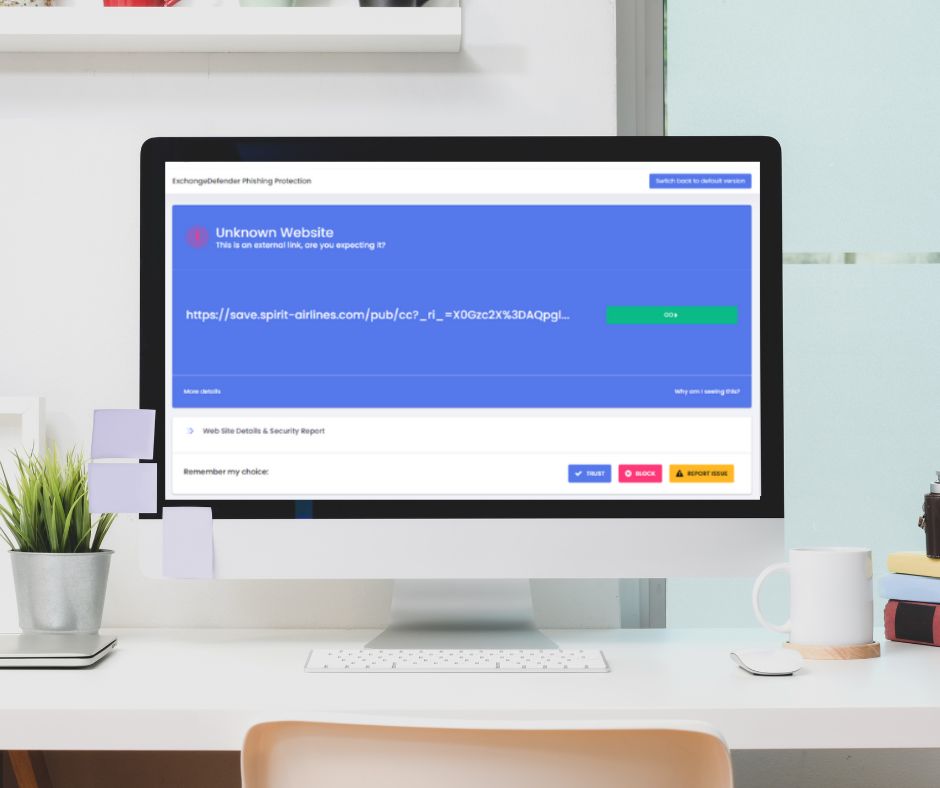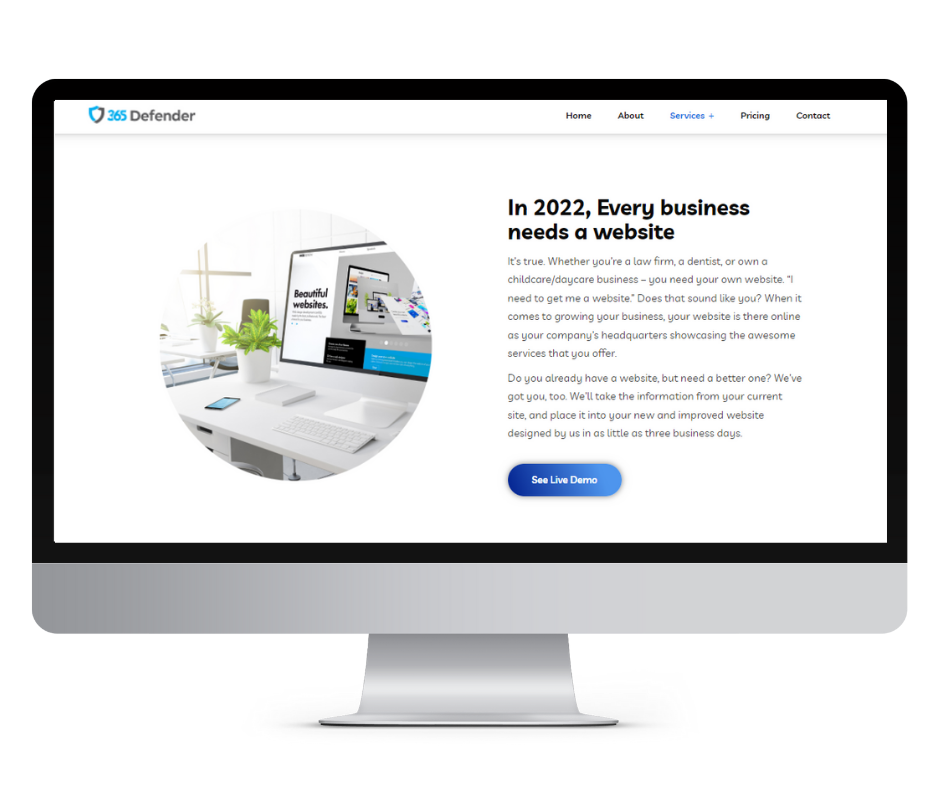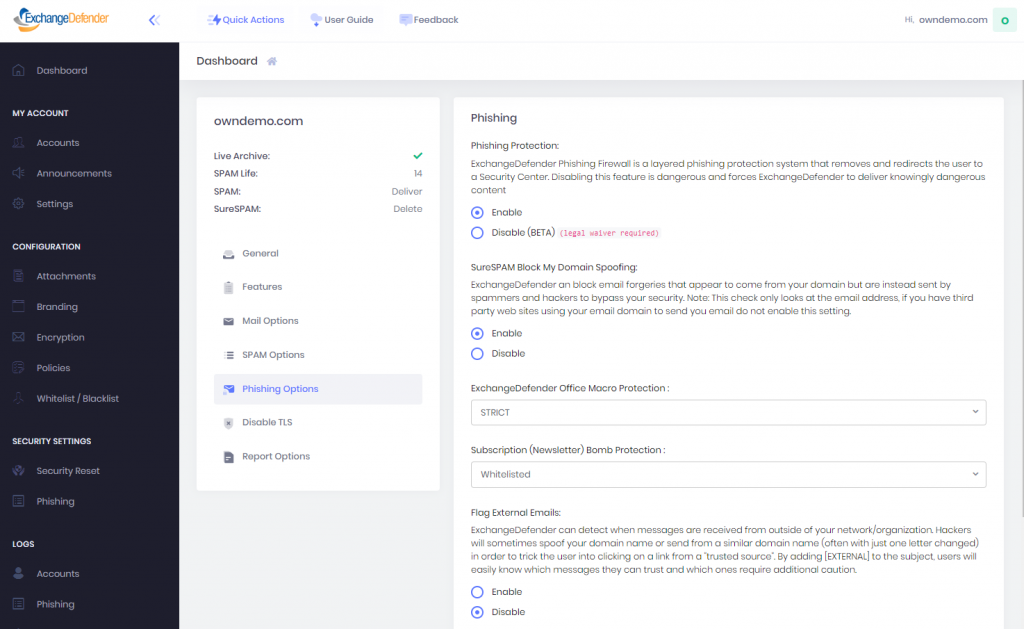ExchangeDefender Phishing Firewall is Live!
As mentioned previously our new ExchangeDefender Phishing Firewall went live in production at noon EST today (March 3rd, 2023) and is already rewriting URLs unique to service provider that manages the domain.
A little bit about the technology
URL / link rewriting is an industry standard used by biggest email providers to rewrite potentially dangerous URLs. When the user clicks on the link they are redirected to a Phishing Firewall site instead of the direct web site address that was in the email. The phishing firewall looks at all the domain policies, allow/block lists, exceptions, and determines if the user should be allowed to proceed to the web site.
When the messages arrive into your organization, instead of https://www.yahoo.com the URL is rewritten to something like https://exchangedefender.xdref.com/url=hash. These masked URLs are only visible to our clients, when they reply to an email the outbound network reverses the process. Outbound network replaces https://exchangedefender.xdref.com/url=hashwith the original URL.
This technology eliminates the possibility that a random hacker can deliver a payload that is one click away from the user. Additionally, it gives the user the ability to check the site reputation, check for viruses, and clearly see the URL they are going (instead of a squashed little tooltip with a 200+ character URL). Essentially, we study how people get hacked with phishing and try to eliminate those issues.
All the sites and services are fully encrypted and partners/clients do not need to worry about certificate renewals, site mappings, etc – everything is automatic and done for you. Set it and forget it just keep an eye on the logs.
Going Forward
As of March 3rd, 2023 all the URLs will be rewritten using service providers id. Main benefit of this upgrade is that it reduces the scope and likelihood that the URL gets inadvertently reported or picked up by another security service that may deem xdref.com to be a masking site for dangerous content.
Additionally, you can configure your firewall to only accept unapproved URLs after a hop through <yourspid>.xdref.com. It also gives you full visibility into everything that happens with the URL, who clicks on it, where they go, etc which is something we do for our clients to address cybersecurity compromise and trace back how it happened (very lucrative service for partners that may be interested in deploying that level of protection.
WEBINAR RECAP: Earn cash rewards, new phishing filter design, and more!
Our latest webinar live session of 2022 just happened a few days ago, and we had so much to share with our partners. Topics covered included our newly launched sister company, 365 Defender, our new referral program that earns you cash rewards, and so much more. Today, we want to share with you the replay of the webinar featuring just the main highlights. You can always watch the replay video anytime by clicking here.

365 Defender – providing affordable cybersecurity services directly to small businesses
ExchangeDefender’s overall strategy for 2022, as we recover from the covid-19 global pandemic, is to focus on enhancing our current cybersecurity services and software. There has been a huge shift in the IT workforce, and IT needs for the common small business which is why we launched 365 Defender. 365 Defender enables small businesses with no IT the ability to access affordable cybersecurity services. Why did we do this? The market demand was overwhelming, especially while we were all working from home. We started getting requests directly from businesses who were in dire need of security. Further, IT and MSP providers providers are specializing in more profitable areas leaving an under-served SMB space.
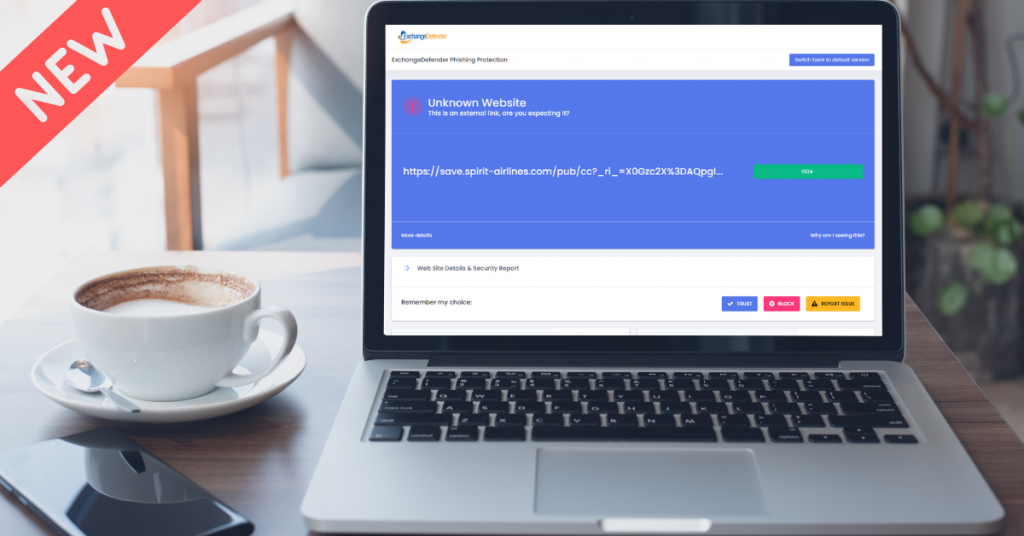
New Phishing Firewall user experience
ExchangeDefender Phishing Firewall has received a major face lift. We’re making it easier to control where your users go when they aren’t paying attention. The new UI enables direct access to malware scans and site security reports. It also features an improved mobile interface with the ability for logging and auditing. Soon, the firewall will also feature phishing and security user training. The new firewall is automatic, and does not require any actions by the user.
In 2022, every business needs a (good) website
We just launched brand new custom website design packages for an affordable price. Currently there are two options: a full one pager website, and a premium three-page responsive website. Pricing begins at just $199, and as a launch promo we are offering our clients the ability to spread the payments over three easy monthly payments. Why did we start offering this service? In a recent survey, tons of partners expressed their website and maintenance frustrations. We knew that we could create a package that includes the website, hosting, and maintenance.
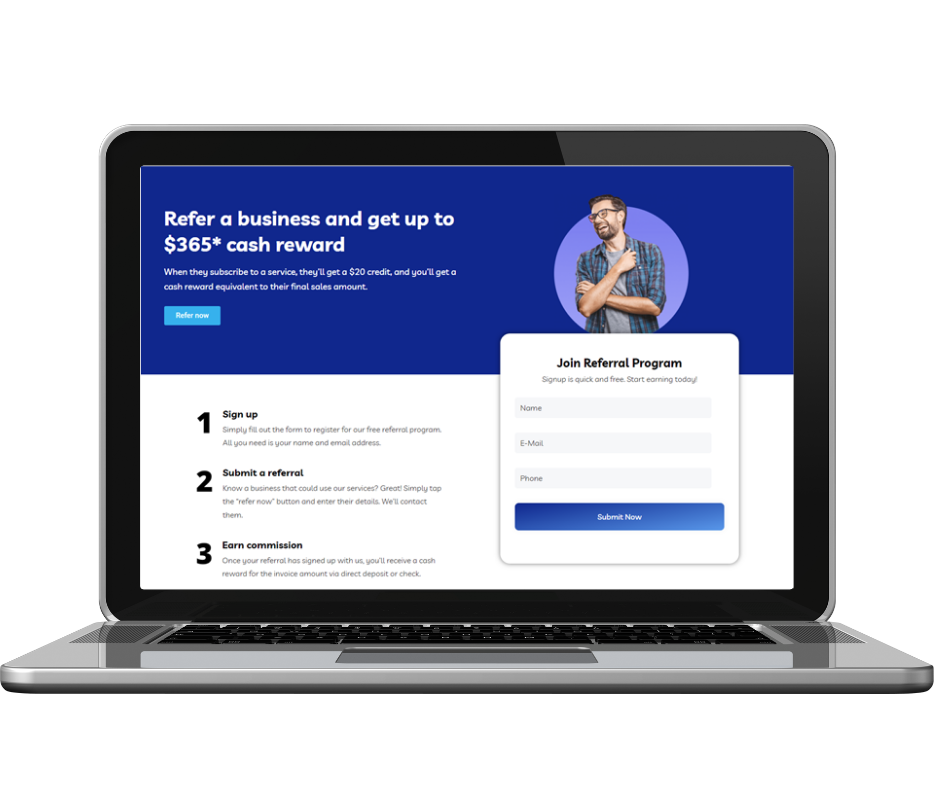
365 Defender Referral Program
Say hello to less work, and more commission with our new 365 Defender Referral Program. Earn up to $365 commission for every referral that becomes a client. When they subscribe to a service, they’ll get a $20 credit, and you’ll get a cash reward equivalent to their final sales amount. The process is simple – sign up for free, submit a company referral, and earn cash.
Phishing protection gets new terminology

At ExchangeDefender, we are unique just like our clients. Our team members are all from different nationalities, backgrounds, and expertise.
We do not aim to offend or demoralize any individual or groups, unless they are spammers or hackers. 🙂
Some of the industry standard terms used in the backend, that have been part of IT for decades, may sound offensive to clients in the modern workplace. Non-technical clients who are not accustomated to traditional IT terms are rightfully shocked when they see terms like “master-slave replication”, “whitelist”, and other similar racially sensitive wording.
SPAM filtering and email security should not be offending our clients so we’ve gone through an audit of our web site, our portals, our mobile apps, and our backend in an effort to rephrase some of the industry terms that may be offensive.
Our client base has changed over the past 24 years, (our services are predominantly used by non-technical staff) and this was a part of our larger effort to make ExchangeDefender more user-friendly.
We want to make our services more accessible for users that have never used ExchangeDefender, or an enterprise security software; you will see fewer IT acronyms. Instead, we’re rephrasing our services to sound like spoken English, for example: To block senders from sending you SPAM you will now add their address to a “Block list”.
How to Protect Yourself from Domain Spoofing and Phishing with ExchangeDefender

At ExchangeDefender we want you to be safe online. One of the biggest and best steps you can take towards that goal is to both protect your domain from being “spoofed” (forged by a spammer) and to block any such forgeries from arriving into your mailbox.
About Spoofing
Spammers and hackers routinely abuse domains that do not have a SPF or DKIM record. They configure their email software to use your domain name for a SPAM campaign or to launch sophisticated phishing attacks. If you’ve ever received an email from yourself, or from a forged government or corporate entity, you’ve been a victim of spoofing. If you’ve ever received thousands of rejections and delivery receipts for messages you never sent, you’ve been a victim of spoofing. Because so many domain owners do not take responsibility for their DNS configuration, this is the most widely abused mechanism.
Good news is, ExchangeDefender can help protect you from these attacks and brand misuse through implementation of SPF, DKIM, and our corporate policies.
SPF (Sender Policy Framework)
ExchangeDefender uses SPF to verify that the email is coming from a source that your organization trusts to send messages. This is typically your email server, our email server, and sometimes a business application (like a hosted CRM) that sends email using your domain name. All others get rejected as forgeries.
How do you setup your SPF record? Simply go to wherever your domain name is hosted (your name server) and add this TXT field to your zone. You may need assistance from your ISP, domain registrar, or whoever is actually running your name servers. If you don’t know who that is, or they are too difficult to use, ExchangeDefender will host your domain free of charge. The TXT record will not have a hostname and the value should be set to the following:
Hostname:
Record type: TXT
Value: v=spf1 include:proxy.exchangedefender.com -all
DKIM (Domain Keys)
ExchangeDefender uses DKIM to validate automated digital signatures. We also sign messages for all customers that rely on ExchangeDefender to send outbound mail (pretty much everyone). This is a 2 step process similar to SPF.
Step 1: Request public key
Go to https://support.ownwebnow.com and open a ticket requesting signatures of your outbound mail. Please specify which domains you wish to sign because each domain must have its own set of keys.
Step 2: Create a DKIM public record
Go to wherever your DNS is hosted and just like in SPF, create a DKIM record:
Hostname: default._domainkey
Record type: TXT
Value: v=DKIM1; k=rsa; s=email; p=MIGfMA0GCSqGSIb3DQEBAQUAA4GNADCBiQKBgQC0SXzBGHoJcBVKyNEntvTiMtoSIH4uiuY6i5hzF47
A2eYb4pB/gtsHpP1vpDgzZvwVLz65nQwnm4wvSFsarKwCyWYyvGwPvBd9+v2Jcrk5dsfHioUDZo5oSvbRY
+e8AD7eo42A/pYdgZxL9KRyZbMsCtHJrAqvYB6LZP0SFVvkYQIDAQAB
Important: This is just an example. You will need to use your own public key generated in Step 1 and provided by us. Also, the value of the TXT record has to be on the same line, if there are any line breaks (if you copy it from an email or web page) please remove them.
Step 3: Update the ticket with us to test deployment
After the DNS record has been created for your domain, we will validate it and if configuration is valid we will start signing your outbound messages going through ExchangeDefender.
After the DNS record has been created for your domain, we will validate it and if configuration is valid we will start signing your outbound messages going through ExchangeDefender.
ExchangeDefender Policy
While we encourage all of our clients to implement both SPF and DKIM, we understand that there are sometimes business scenario cases under which this is impossible. If you find yourself in this predicament you should immediately change where your name servers are hosted and take full control of your organizations identity online. But if that is still something you may not be able to do, ExchangeDefender can still protect you from phishing attacks and spoofing launched using your own domain name. If you’ve ever received email from yourself or from a colleague (but the email actually came from a server in Poland) then this setting will help you.
Go to https://admin.exchangedefender.com and login as the domain administrator (username is your domain name).
Click on Security Settings > Phishing
Under “Flag External Emails” click on Enable and then Save.
After this setting is applied, all messages from your domain that were sent from outside of the ExchangeDefender network will go into the SureSPAM quarantine. Just tell users not to trust, whitelist, or release messages that are coming from your own domain because they are certainly not legitimate.Note: This is the option of last resort and will not stop hackers or spammers from abusing your domain for phishing, spamming, or hacking. However, it will stop those messages from arriving directly into your users mailbox. If you already have a valid SPF record (with -all, not ~all) and DKIM in production, this setting is not necessary as ExchangeDefender will automatically reject messages that fail SPF/DKIM validation.
If you have any questions or concerns about ExchangeDefender and implementation of SPF, DKIM, or phishing policies please feel free to contact us.
ExchangeDefender Phishing Firewall Whitelist and Blacklist explained
ExchangeDefender Phishing Firewall goes online tomorrow, and we wanted to explain our policy and our implementation of the URL rewriting/redirection because it is a departure from a traditional IT hierarchy where organizational policies override group and user requirements.
Our goal with ExchangeDefender PF is to provide a level of alert and notification to our clients that is designed to provide additional information about the link they clicked on. As we scale this service out, that will be it’s purpose: Be aware of what you clicked on, and prepare for what you’re about to see. Phishing, and spear phishing in particular, is designed to be a convincing fraudulent identity theft of an organization you know and trust (your bank, your coworker, your vendors) and our goal is to help you discern if something is valid or not.
Our whitelist/blacklist implementation is in line with “we inform, you decide” mantra, as we cannot outright block you from actually going to the dangerous site. That is the responsibility of your IT department, your network management, and your organization.
How do Whitelists and Blacklists work?
In ExchangeDefender we have 4 sets of whitelists and blacklists: user, domain/organization, service provider, and global. Our global lists are automatically populated for our service providers and when they protect a domain with ExchangeDefender, those entries are applied on the domain/organization level, and further down to the end user. As we continue to monitor, manage, and get additional intelligence about dangerous sites we will continue to curate these lists as a part of the service.
For example, we might find out that *.vlad8150.microsoft.net is a Microsoft Azure instance that is attempting to spread malware. We will promptly add it to our global blacklist and that site will now be blacklisted for every ExchangeDefender user. When they click on a link that leads them to that domain, they will see the ExchangeDefender PF notice with the URL in red. User will then have the option of ignoring it and proceeding to the site, or adding it to their whitelist. If they whitelist a domain/web site, any future requests will bypass ExchangeDefender PF web site and automatically redirect to the target URL.
The hierarchy of whitelists/blacklists is as follows, whichever rule is defined on the top is the one that is applied to the user when they click on a link.
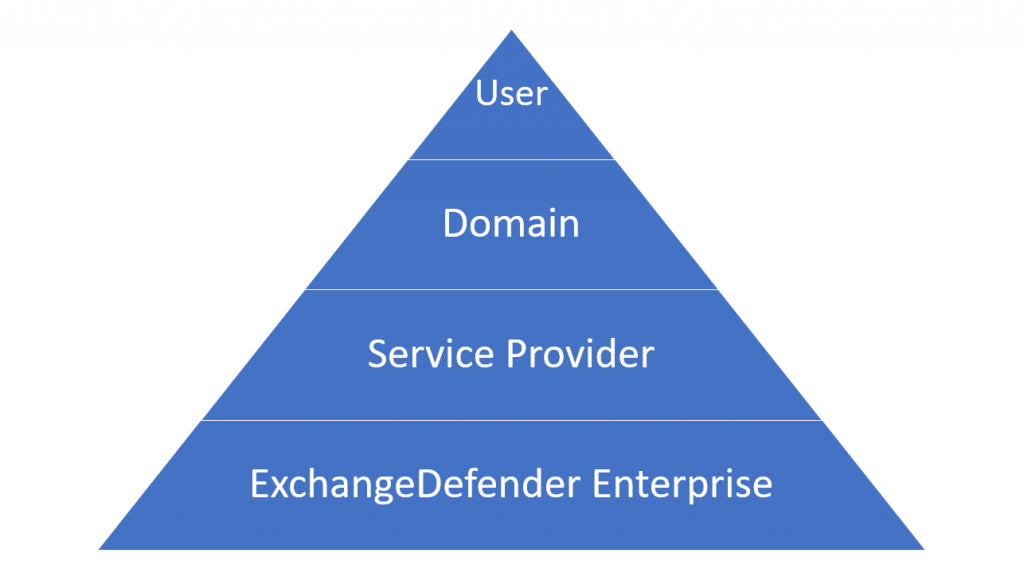
But why, why not implement policies like NTFS, access list, or any other policy in which global deny rules override end user policies?
Simply put: Traffic blocking should be done on the network level. We are simply the alert service, we will advise you when we see something dangerous and it’s up to you to discern if the site is trustworthy or not. We believe that this implementation will cause the least amount of interruption to the day-to-day use.
That said, we have been working on additional controls and policies to help our service providers and CIO’s better enforce company security policies. As with everything, security policies must be implemented in layers – and dangerous content should be enforced in accordance to business requirements. This means that if your clients should not be downloading .exe files, the network firewall should be doing that. We don’t have the means to do that as an email service – users can right click on the email, put it in notepad, remove https://r.xdref.com/url= from the link and go straight to the web site.
How do we manage them?
ExchangeDefender PF whitelists are available at every level of ExchangeDefender. Simply add a site to either a whitelist and blacklist and ExchangeDefender will automatically propagate your rules down through the entire organization. Users will have the ability to add / block sites from the ExchangeDefender PF in real-time and their settings will be preserved in their account only.
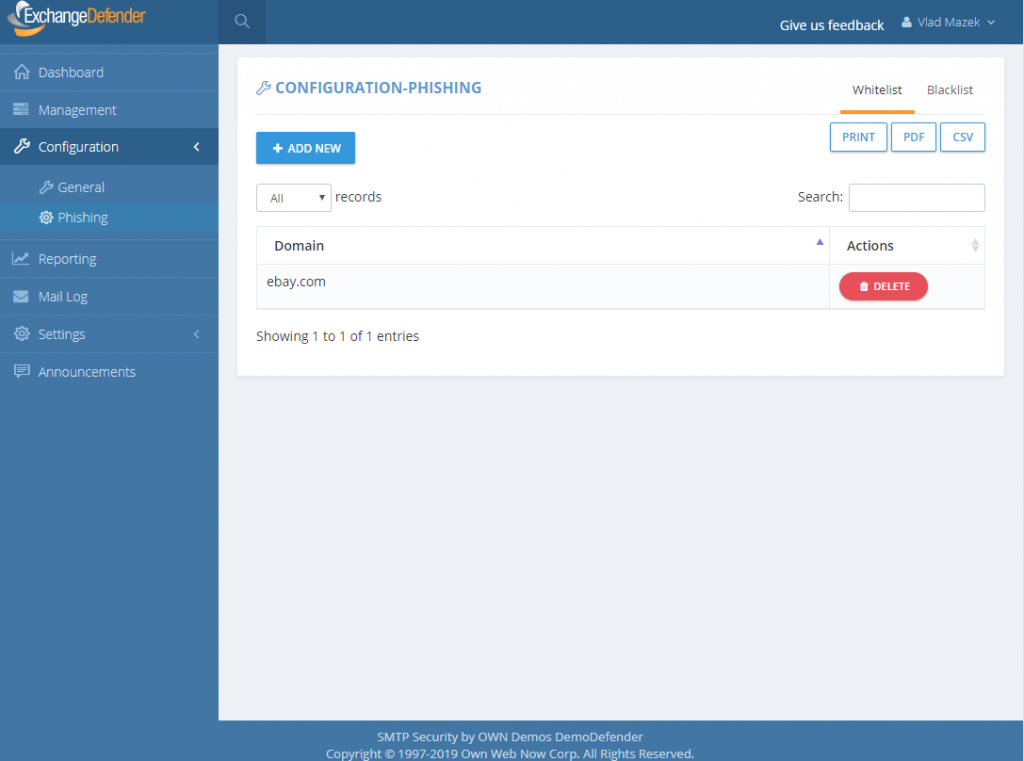
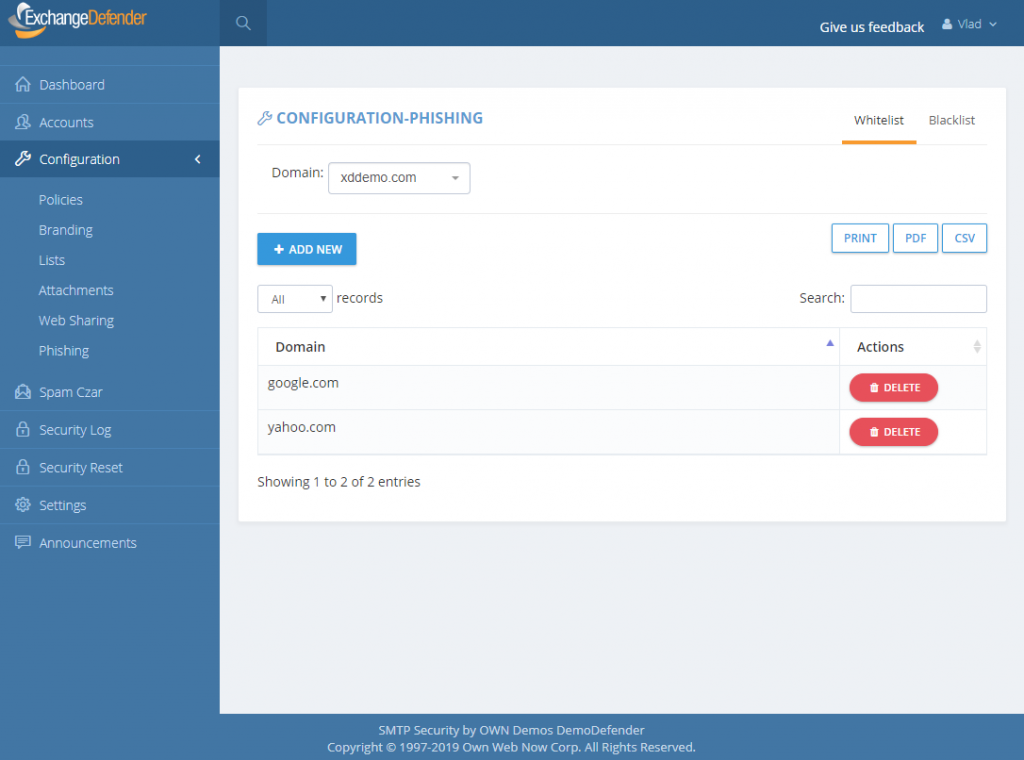
P.S. Officially the service goes online tomorrow, unofficially it’s been in place for months we just haven’t rewritten a single URL except for the emails you received from us – we have worked very hard on the implementation and we don’t expect major problems but will have staff on hand around the clock to address any issues immediately. Spear phishing is an epidemic, over 90% of compromises start with a link in an email. We will handle any glitches, bugs, and issues as fast as possible and have full confidence that having an alerting service with potential problems is far more useful than having nothing and leaving clients exposed.
ExchangeDefender Phishing Firewall FAQ
ExchangeDefender Phishing Firewall officially launches tomorrow, June 12th, 2019.
Every service provider and every user will be contacted with the information about the new service. Since some users may see the redirection site, we wanted to assure everyone was aware of the service, how it works, what it looks like, and what it does to protect them.
Note from Vlad: We hate changing the user experience. We understand that every time we change anything there will be an issue, folks don’t like having their cheese moved, I get it. However, this isn’t a futile exercise in self-promotion, up-selling, cross-selling, or useless noise: we are doing this to eliminate the problem that 90% of security compromises are triggered by. This implementation comes down to ethics: If I know that something is 90% likely to hurt you, and I have the means to protect you, and I choose to let you get hurt anyhow… why would you ever do business with me or ExchangeDefender? I understand we may lose some business over this, and I am willing to make less money in order to do a better job for people that trust us with their business.
Here are the answers to some questions we’ve already received:
Q: Does ExchangeDefender PF work on every device I receive email on?
A: Yes, ExchangeDefender PF automatically encodes all links sent through our system in HTML messages and redirects them through ExchangeDefender PF. This means that the link will be secured no matter which device you use to access your ExchangeDefender-protected email.
Q: Does ExchangeDefender PF protect me from non-email links?
A: ExchangeDefender only protects you from email links in HTML messages sent to your email address through ExchangeDefender. If your mail client downloads mail from 3rd party external services (Yahoo,
AOL, Microsoft, Google) that are not protected by ExchangeDefender, you will not be protected.
Q: Is ExchangeDefender PF available in ExchangeDefender Essentials?
A: ExchangeDefender PF is only available in ExchangeDefender Pro and ExchangeDefender Enterprise.
Q: Is there any way to turn off URL encoding for specific domains or users?
A: ExchangeDefender encodes the URL at the edge, as the message is being scanned for malware and other phishing forgeries.
Q: I don’t want to see the ExchangeDefender PF warning/site, can I bypass it?
A: Yes, you can simply whitelist the domain and ExchangeDefender PF will not be displayed. Whitelisted domains are automatically displayed without ExchangeDefender PF. ExchangeDefender maintains a list of known good/legitimate domains so the likelihood that you will see a dangerous (or questionable) website is very low. Additionally, your IT department or IT Solution Provider has access to organization-wide whitelist and can bypass ExchangeDefender PF to any site you need to visit.
Q: Is it possible to still get hacked/compromised even with ExchangeDefender PF?
A: ExchangeDefender PF simply applies your organizational policies to traffic and gives you additional information about the link you have clicked on. If you ignore warnings, or if you proceed to a dangerous site as a part of your organizational policy, you can still be compromised.
Q: Is there anything special I need to do on my network in order to support the redirection?
A: No, you should not have to make any modifications to your clients network in order to support this. If you do something exceptionally unusual (we would have contacted you separately, DoD requirement) and only have an allow access policy while blacklisting the rest of the Internet, redirection happens through https://r.xdref.com domain that needs to be in the safe sites.
Q: Can I turn URL rewriting off?
A: The ExchangeDefender URL rewriting code is implemented at the edge without regard for domain/user policies. In order not to introduce delays in processing, this is a global rule. If you are concerned about your clients seeing the redirection screen, whitelist the domains they typically go through. If we get complaints about it, we will look at deploying this policy further down in the scanning path which will slow down processing times for domains that opt out of the service and that feature is already in the development queue.
Q: Can I see the copy of the messages you are sending users, so I know what to expect?
A: Here is a copy of the message in PDF and Outlook format.
Q: Will the links stay live for X number of years for compliance purposes?
A: There is no expiration date for the links, as clearly stated in our Privacy Policy we do not collect or archive the links that you click on or that we encode, they will stay in your downloaded / cached / archived messages. While many regulatory requirements have message retention policy expectations, those requirements do not extend to external content, ie: you have to archive the message, you DO NOT have to archive the documents that are externally linked on third party sites. Either way, messages will continue to redirect as long as we stay in business.
Q: Can I get a list of good/bad sites for my compliance records?
A: Please contact our compliance officer at compliance@ownwebnow.com with the letter from your regulatory body and we will do our best to provide this confidential information ASAP.
ExchangeDefender: Overhaul of Phishing Protection
ExchangeDefender is thrilled to announce the new Phishing Firewall in the cloud, going into full production – Wednesday, June 12th, 2019 for all ExchangeDefender Pro and Enterprise protected clients. The old way of highlighting, underlining, inserting warnings and so on will be removed from the service at the same time because it lacks the ability to protect clients in real-time.
The ExchangeDefender Phishing Firewall (EPF) is a real-time, active pishing protection. As ExchangeDefender processes inbound mail, it will rewrite every link to proxy it through EPF when user clicks on it. If the site is safe, the user will be automatically redirected to it and will not even know that EPF is in the way. If the site is not on the safe list, end users will see this warning:

They will have the option to just click on the link and proceed, add to whitelist (at which point they are automatically allowed through in the future) or add to blacklist.
Because of the way phishing works, and all identity theft or forgery in general, it is impossible to secure email messages in transit without making annoying modifications to the message that often distort the look and feel of it. Majority of those links are in the 95% of the mail that passes through ExchangeDefender as SPAM/SureSPAM, meaning that they would never even be seen by anyone. By moving the Phishing Firewall to the cloud, we can now secure every device and provide additional metrics and advisory on top of it to protect our clients from 0-day exploits.
This feature is provided to our clients free of charge and replaces expensive “security awareness training” solutions that users typically hate and do nothing to adequately secure the client. With Exchange Phishing Firewall we enable our clients to create custom policies, maintain whitelists, blacklists, get enterprise reporting and more. It further allows us to go one step beyond – in the upcoming releases we’ll offer the ability to display a screenshot of the site as well as link intelligence data (How long ago was the domain name registered? Where is the IP you’re about to go to located? Is the domain a close spelling error of a widely recognized site? Is the forged site just a cloud hosted Google, Microsoft or Amazon cloud service instance that is holding or redirecting you to another more dangerous location?)
If you’re currently on ExchangeDefender Essentials, we encourage you to schedule a demo with our team to check this feature out as it’s significantly cheaper than antivirus or “security training” solutions and will do a far better job. If you’re on ExchangeDefender Pro or ExchangeDefender Enterprise, you will get this feature free of charge. On Monday, June 10 we will send an email notification announcing this launch to our partners, MSPs, and Service Providers. On Tuesday, June 11 we will send an email notification to end users. Finally, on Wednesday, June 12th we will go live with the service and hope to minimize the annoyance of phishing once and for all. Email is the single most popular attack vector, with 91% of the compromises starting through a phishing attack, and we look forward to protecting all our users even better.
Phishing: Beware of Strangers
This Thursday, June 6th, we will be announcing a major overhaul in the way we deal with spear phishing SPAM. No, it’s not a mind-blowing patent-pending stroke-of-genius sort of stuff, it’s much closer to what your parents told you growing up: Don’t get into a car with strangers don’t click on links or open attachments from strangers.
In a way, ExchangeDefender has had protection from this issue for years. If you had a decent IT Solution Provider implementing ExchangeDefender for you, they would have setup your SPF record and eliminated this issue – but many don’t. Or they would have turned on ExchangeDefender protection where all messages spoofing/forging your domain would automatically get junked – almost none of them do. Which is why ExchangeDefender as a service has become less of an IT tool and more of an end user suite of services to get stuff done.

When features like this are left disabled “because they might become support issues” it becomes really difficult to secure users. But I get it, IT companies have a business to run too, which is why we’ve really stepped up our support efforts and are going to be there to help folks get things done without becoming an additional problem for the IT department. Doing so has really made us rethink how we implement features and how the service behavior needs to speak the same language as the end user. Which brings me to phishing beyond forgeries.
Can you spot a stranger?One of the new phishing protection features in ExchangeDefender will allow you to flag messages that are coming from outside of your organization. You will have two settings – to modify the subject and to modify the header of the message so when you look inside of your mailbox you’ll know what came from a stranger right away. Try it:
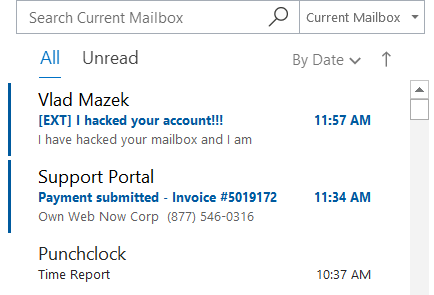
Even from the message listing you’ll know which messages shouldn’t even be opened. But suppose you ignored even that – you can set another warning, printed inside of the message, giving the user even more of an instruction of what to do.
Warning: Message was sent from outside of the organization. Do not click on links or open attachments if you don’t recognize the sender.
Far from subtle. And it has to be – because most people check email quickly, between tasks, or are simply interrupted by it. ExchangeDefender has your back, and we’ll make sure we alert you to possible issues before they become problems. Which we hope everyone will be aboard with.
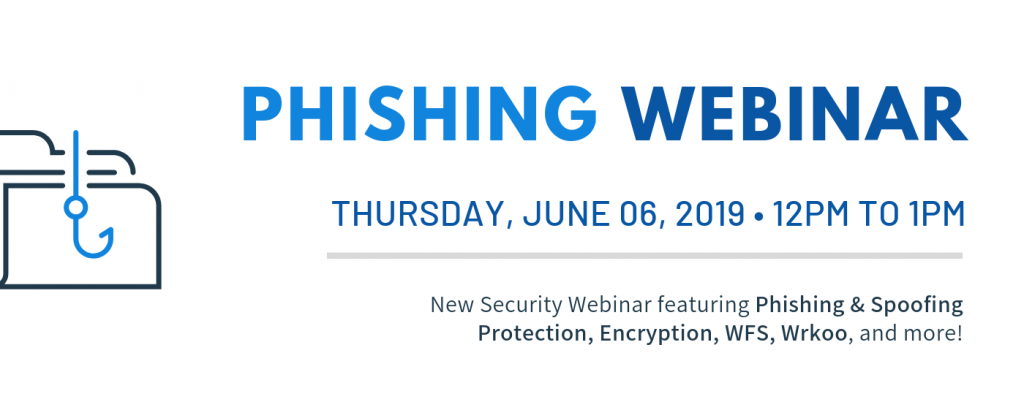
Please join us, June 6th at Noon, for our NEW webinar featuring ExchangeDefender’s Phishing and Spoofing protection, plus see what’s new with Encryption, WFS, and Wrkoo!
ExchangeDefender and Mobile Device Security
Mobile Device Security
ExchangeDefender protects pretty much any device that has access to email – and a category most prone to email-borne security exploits are mobile devices. ExchangeDefender Pro and our Exchange hosting services can nearly eliminate an attack vector through malware detection, phishing attempt alerts and can help you wipe a device remotely without having physical access to it.
The number one way to get malicious content to a mobile device is still via email – it’s so easy to trick a user to click on a malicious link and on a mobile device it is far harder to tell if the sender is legitimate or spoofed. Hackers format messages in such a way that it’s easy to see legitimate links and accidentally click on malicious ones so ExchangeDefender is extremely useful in making sure any such dangerous content is stripped off in the cloud. Anyone can email any content they wish to your mobile device and with ExchangeDefender you are assured that even the most aggressive of 0 day exploits do not arrive in your users mailbox.
Phishing, or forging/deceiving an identity of a third party, is a popular way for hackers to get users to click on links that appear to be legitimate. It’s very easy to copy a look of an Amazon or bank email notification and get the user to click on the link that takes them to a forged web site to download malicious content. Unlike Malware protection, which removes dangerous content from the email, phishing protection deactivates links in email messages and highlights phishing attempts when links to third party sites do not match the domain name of the sender. If you were getting an email from jeff@amazon.com would he be including a link to http://1001smallbizscamsandfrauds-519.org? Our system will deactivate that link and keep your user safe from whatever is on the malicious site.
Remote Wipe & Device loss management
In the event that your users device is lost, users employment is terminated, you don’t have physical access to the device but need to wipe it for security reasons – you can start a remote device wipe through your Outlook Web App under Settings > Mail > Options > Mobile devices and selecting Wipe Device. Within moments the device will be wiped clean of any data, content and settings and this works for both iPhone and Android devices (tables and phones).
ExchangeDefender Pro offers users a VPN server to connect to in a secure manner no matter where they go. Public Wifi hotspots tend to have questionable security at best and can be used to compromise a device that is connecting blindly across the Internet. Connecting your phone automatically to a VPN can assure that email access (and all the confidential data in the email) can never be snooped on.
We are currently in beta with our mobile OTP/2FA applications which will further turn the mobile device into a part of your authentication so you don’t have to remember complex passwords at all. In the meantime, it’s important to let the users know what ExchangeDefender is currently capable of doing for them and to enable/configure those features so they are actively protecting every email user in your organization.

